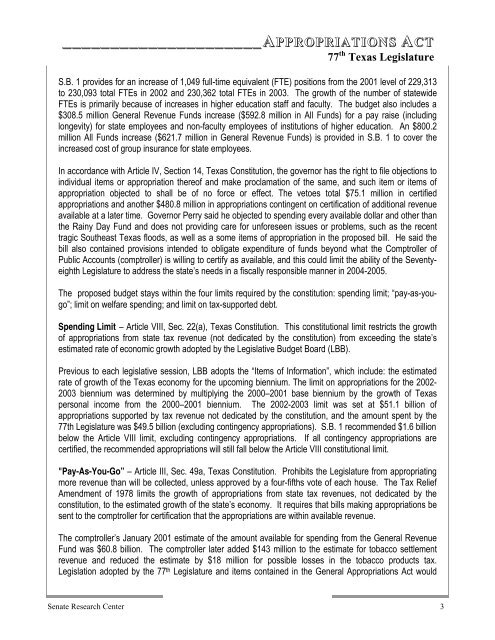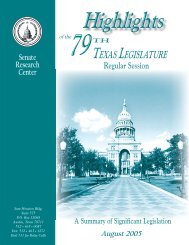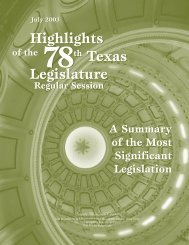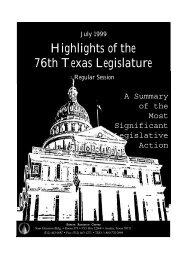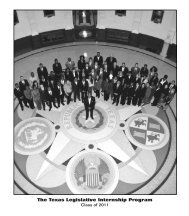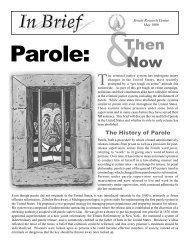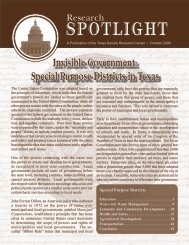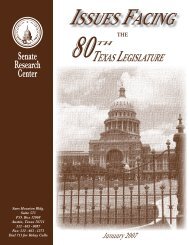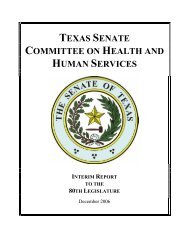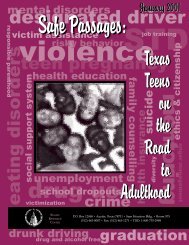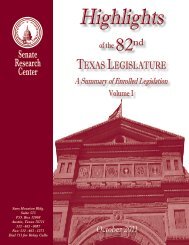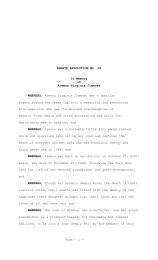Highlights 77th Texas Legislature - Senate
Highlights 77th Texas Legislature - Senate
Highlights 77th Texas Legislature - Senate
Create successful ePaper yourself
Turn your PDF publications into a flip-book with our unique Google optimized e-Paper software.
_____________________ A PPROPRIATIONS<br />
PPROPRIATIONS ACT<br />
77 th <strong>Texas</strong> <strong>Legislature</strong><br />
S.B. 1 provides for an increase of 1,049 full-time equivalent (FTE) positions from the 2001 level of 229,313<br />
to 230,093 total FTEs in 2002 and 230,362 total FTEs in 2003. The growth of the number of statewide<br />
FTEs is primarily because of increases in higher education staff and faculty. The budget also includes a<br />
$308.5 million General Revenue Funds increase ($592.8 million in All Funds) for a pay raise (including<br />
longevity) for state employees and non-faculty employees of institutions of higher education. An $800.2<br />
million All Funds increase ($621.7 million in General Revenue Funds) is provided in S.B. 1 to cover the<br />
increased cost of group insurance for state employees.<br />
In accordance with Article IV, Section 14, <strong>Texas</strong> Constitution, the governor has the right to file objections to<br />
individual items or appropriation thereof and make proclamation of the same, and such item or items of<br />
appropriation objected to shall be of no force or effect. The vetoes total $75.1 million in certified<br />
appropriations and another $480.8 million in appropriations contingent on certification of additional revenue<br />
available at a later time. Governor Perry said he objected to spending every available dollar and other than<br />
the Rainy Day Fund and does not providing care for unforeseen issues or problems, such as the recent<br />
tragic Southeast <strong>Texas</strong> floods, as well as a some items of appropriation in the proposed bill. He said the<br />
bill also contained provisions intended to obligate expenditure of funds beyond what the Comptroller of<br />
Public Accounts (comptroller) is willing to certify as available, and this could limit the ability of the Seventyeighth<br />
<strong>Legislature</strong> to address the state’s needs in a fiscally responsible manner in 2004-2005.<br />
The proposed budget stays within the four limits required by the constitution: spending limit; “pay-as-yougo”;<br />
limit on welfare spending; and limit on tax-supported debt.<br />
Spending Limit – Article VIII, Sec. 22(a), <strong>Texas</strong> Constitution. This constitutional limit restricts the growth<br />
of appropriations from state tax revenue (not dedicated by the constitution) from exceeding the state’s<br />
estimated rate of economic growth adopted by the Legislative Budget Board (LBB).<br />
Previous to each legislative session, LBB adopts the “Items of Information”, which include: the estimated<br />
rate of growth of the <strong>Texas</strong> economy for the upcoming biennium. The limit on appropriations for the 2002-<br />
2003 biennium was determined by multiplying the 2000–2001 base biennium by the growth of <strong>Texas</strong><br />
personal income from the 2000–2001 biennium. The 2002-2003 limit was set at $51.1 billion of<br />
appropriations supported by tax revenue not dedicated by the constitution, and the amount spent by the<br />
<strong>77th</strong> <strong>Legislature</strong> was $49.5 billion (excluding contingency appropriations). S.B. 1 recommended $1.6 billion<br />
below the Article VIII limit, excluding contingency appropriations. If all contingency appropriations are<br />
certified, the recommended appropriations will still fall below the Article VIII constitutional limit.<br />
"Pay-As-You-Go” – Article III, Sec. 49a, <strong>Texas</strong> Constitution. Prohibits the <strong>Legislature</strong> from appropriating<br />
more revenue than will be collected, unless approved by a four-fifths vote of each house. The Tax Relief<br />
Amendment of 1978 limits the growth of appropriations from state tax revenues, not dedicated by the<br />
constitution, to the estimated growth of the state’s economy. It requires that bills making appropriations be<br />
sent to the comptroller for certification that the appropriations are within available revenue.<br />
The comptroller’s January 2001 estimate of the amount available for spending from the General Revenue<br />
Fund was $60.8 billion. The comptroller later added $143 million to the estimate for tobacco settlement<br />
revenue and reduced the estimate by $18 million for possible losses in the tobacco products tax.<br />
Legislation adopted by the 77 th <strong>Legislature</strong> and items contained in the General Appropriations Act would<br />
<strong>Senate</strong> Research Center 3


